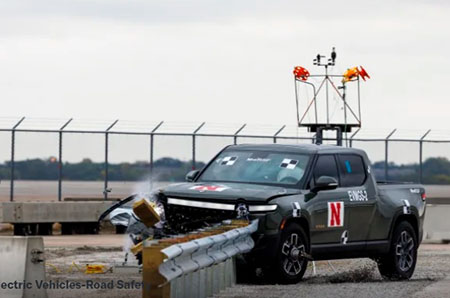by WorldTribune Staff / 247 Real News February 1, 2024
America’s highway guardrail system is not capable of handling the extra force of electric vehicles (EVs) that are much heavier than gas-powered cars, according to crash test data released Wednesday by the University of Nebraska.

EVs, which typically weigh 20 percent to 50 percent more than gas-powered vehicles, can easily crash through steel highway guardrails, the crash tests showed. EV batteries alone can weigh almost as much as a small gas-powered vehicle. EVs also have lower centers of gravity.
Engineers at Nebraska’s Midwest Roadside Safety Facility watched as an electric-powered pickup truck hurtled toward a guardrail installed on the facility’s testing ground on the edge of the local municipal airport. The nearly 4-ton (3.6 metric ton) 2022 Rivian R1T tore through the metal guardrail and hardly slowed until hitting a concrete barrier yards away on the other side.
“We knew it was going to be an extremely demanding test of the roadside safety system,” said Cody Stolle with the facility. “The system was not made to handle vehicles greater than 5,000 pounds.”
Michael Brooks, executive director of the nonprofit Center for Auto Safety noted that guardrails are intended to keep cars from careening off the road at critical areas, such as over bridges and waterways, near the edges of cliffs and ravines and over rocky terrain, where injury and death in an off-the-road crash are much more likely.
“Guardrails are kind of a safety feature of last resort,” Brooks said. “I think what you’re seeing here is the real concern with EVs — their weight. There are a lot of new vehicles in this larger-size range coming out in that 7,000-pound range. And that’s a concern.”
Brooks said the weight of EVs will affect everything from faster wear on residential streets and driveways to vehicle tires and infrastructure like parking garages.
“A lot of these parking structures were built to hold vehicles that weighed 2,000 to 4,000 pounds — not 10,000 pounds,” he said. “What really needs to happen is more collaboration between transportation engineers and vehicle manufacturers. That’s where you might see some real change.”
Last year, the National Transportation Safety Board expressed concern about the safety risks heavy electric vehicles pose if they collide with lighter vehicles.
Quality Resource for Citizen Journalists
